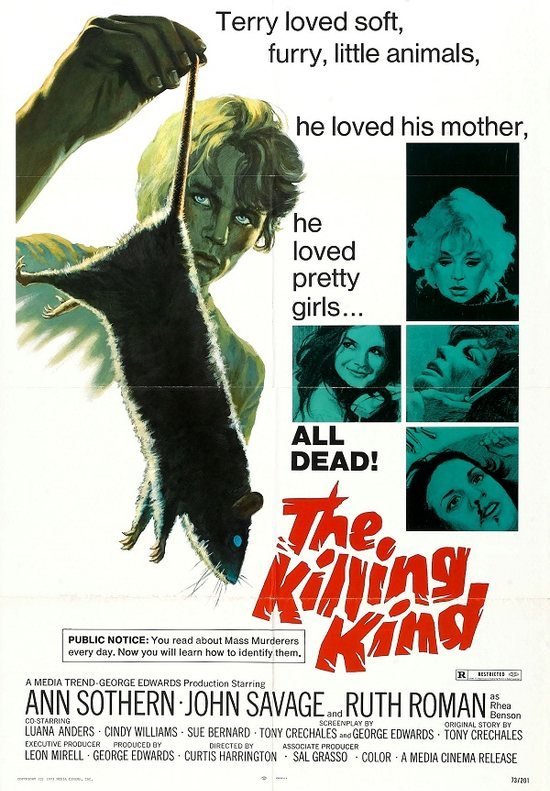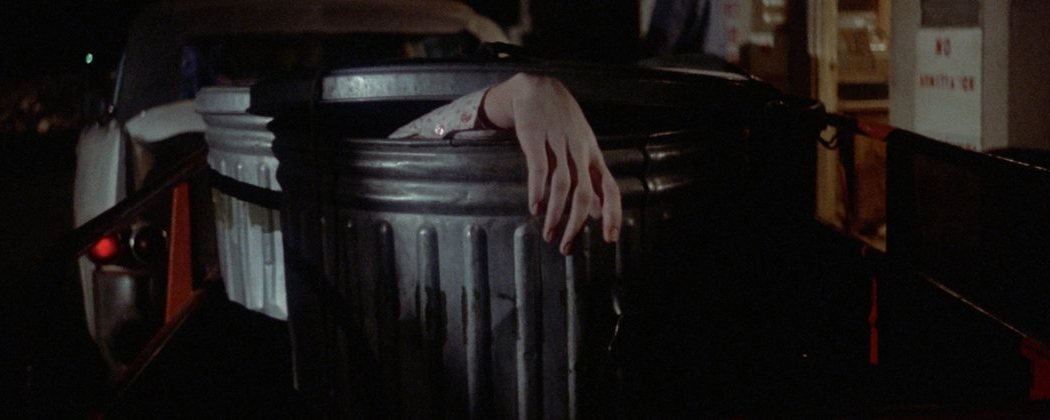THE KILLING KIND: Stylish Psychosis In The Land Of Quiet Desperation
If you're looking for an esoteric auteur of cult cinema to obsess over, you'd do well to check out the work of Curtis Harrington. He's still not as well-known in offbeat cinema circles as he should be but a select few know of the fascinating string of feature films he made in the '60s and early '70s. His work during that time was sophisticated, subtle yet decadent, reflecting his status as someone who loved old Hollywood yet also collaborated with Kenneth Anger.Harrington was known for his ability to conjure a sinister yet elegant atmosphere and a unique skill for tales of horror built around disintegrating psyches. You can see a full display of those skills in The Killing Kind, an underrated blend of character study and serial killer movie. Its antihero is Terry (John Savage), a disturbed manchild who was browbeaten into participating in a gang rape and got sent to prison for it. He gets out as the film begins, returning to the home of his domineering, too-close mother, Thelma (Ann Sothern), who has converted her elegant old-L.A. home into a rooming house for primarily elderly women.Terry finds himself tempted/repelled by Lori (Cindy Williams), a rare young tenant in the house, as he plots revenge against the rape victim (Sue Bernard) who blamed him alone for the crime as well as the lawyer (Ruth Roman) who failed to keep him out of prison. He also has to contend with Louise (Luana Anders), a repressed spinster neighbor who develops a crush on Terry as she nurses a grudge against her grouchy, invalid father (Peter Brocco). The result has it's skin-crawling moments but not in the shocker/horror style that the premise might suggest. Instead, The Killing Kind focuses on the kind of existential loneliness and stifled emotions that can take over a person's mind when they're dealing with curdled dreams. Terry has the psycho's urge to kill but he's also confused about his sexuality (which he associates with violence) and frustrated by his inability to express himself in a healthy manner. Writers George Edwards and Tony Crechales really lean into this psychological approach, bringing in hints of sleaze and horror but never losing sight of the character study element. They really do impressive work in the third act, creating an ending that is unexpectedly moving as it is darkly tragic.Harrington's natural gift for blurring the line between horror and psychological character exploration serves him well here. He understands the Terry/Thelma relationship is the heart of the film and builds everything around it, devoting a lot of time to powerful scenes detailing how Terry veers between love and resentment for a mother who loves him but tries to steamroll over his issues. Harrington gets powerful performances from both actors: Savage does interesting Method-style work as a bundle of confused impulses that periodically erupts while Sothern slowly peels back layers of irony and acerbic wit to reveal a mother haunted by her inability to care for her son.
The result has it's skin-crawling moments but not in the shocker/horror style that the premise might suggest. Instead, The Killing Kind focuses on the kind of existential loneliness and stifled emotions that can take over a person's mind when they're dealing with curdled dreams. Terry has the psycho's urge to kill but he's also confused about his sexuality (which he associates with violence) and frustrated by his inability to express himself in a healthy manner. Writers George Edwards and Tony Crechales really lean into this psychological approach, bringing in hints of sleaze and horror but never losing sight of the character study element. They really do impressive work in the third act, creating an ending that is unexpectedly moving as it is darkly tragic.Harrington's natural gift for blurring the line between horror and psychological character exploration serves him well here. He understands the Terry/Thelma relationship is the heart of the film and builds everything around it, devoting a lot of time to powerful scenes detailing how Terry veers between love and resentment for a mother who loves him but tries to steamroll over his issues. Harrington gets powerful performances from both actors: Savage does interesting Method-style work as a bundle of confused impulses that periodically erupts while Sothern slowly peels back layers of irony and acerbic wit to reveal a mother haunted by her inability to care for her son. The film further benefits from an elegant, subtle visual frame created by cinematographer Mario Tosi of Carrie and The Stunt Man fame, deploying a soft-focus approach for the film's depiction of a faltering relationship in a home that seems stuck in time. There's also a sparingly used but elegant score from Andrew Belling that subtly teases out the film's tone of muted tragedy.Finally, Harrington fleshes out the episodic approach of his script with impressive work from his supporting cast: Bernard and Roman create vivid vignettes in short but memorable scenes with Savage and Anders nearly steals the film with her work as the more quietly disturbed neighbor. She and Savage share one of the film's finest scenes by the house's pool at night, both revealing forbidden desires and painful honesty in a way that is by turns creepy and heartbreaking.To sum up, The Killing Kind is one of Harrington's best films and an excellent showcase for his esoteric but worthwhile skills. If you're looking for an initiation into his haunted cinematic world, this is a memorable way to enter that sinister kingdom.
The film further benefits from an elegant, subtle visual frame created by cinematographer Mario Tosi of Carrie and The Stunt Man fame, deploying a soft-focus approach for the film's depiction of a faltering relationship in a home that seems stuck in time. There's also a sparingly used but elegant score from Andrew Belling that subtly teases out the film's tone of muted tragedy.Finally, Harrington fleshes out the episodic approach of his script with impressive work from his supporting cast: Bernard and Roman create vivid vignettes in short but memorable scenes with Savage and Anders nearly steals the film with her work as the more quietly disturbed neighbor. She and Savage share one of the film's finest scenes by the house's pool at night, both revealing forbidden desires and painful honesty in a way that is by turns creepy and heartbreaking.To sum up, The Killing Kind is one of Harrington's best films and an excellent showcase for his esoteric but worthwhile skills. If you're looking for an initiation into his haunted cinematic world, this is a memorable way to enter that sinister kingdom. Blu-Ray Notes: This one made its hi-def debut courtesy of Vinegar Syndrome. It's a got a fresh 2K scan that looks great. Better yet, the extras carry over an interview included on the past Dark Sky DVD and add an additional interview plus a commentary track by filmmakers/Harrington fans David DeCoteau and David Del Valle.Trivia Note: anyone who enjoys this film might also want to check out The Attic from 1980. Screenwriters Crechales and Edwards resurrected the spinster and father characters from a subplot in this film and gave them their own story: in The Attic, this duo is played by Carrie Snodgress and Ray Milland. Edwards directed and it has a vibe similar to The Killing Kind.
Blu-Ray Notes: This one made its hi-def debut courtesy of Vinegar Syndrome. It's a got a fresh 2K scan that looks great. Better yet, the extras carry over an interview included on the past Dark Sky DVD and add an additional interview plus a commentary track by filmmakers/Harrington fans David DeCoteau and David Del Valle.Trivia Note: anyone who enjoys this film might also want to check out The Attic from 1980. Screenwriters Crechales and Edwards resurrected the spinster and father characters from a subplot in this film and gave them their own story: in The Attic, this duo is played by Carrie Snodgress and Ray Milland. Edwards directed and it has a vibe similar to The Killing Kind.


